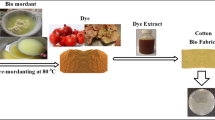Abstract
Chestnut shells, which are a byproduct of agricultural and food processing industries, contain various compounds such as polyphenols and flavonoids that are beneficial to human health. Furthermore, the brownish pigment in chestnut shells is often used to dye textiles. This study explores the feasibility of using chestnut shells—a biowaste—to dye wool fabric using a sustainable textile dyeing process that can impart beneficially functional properties to the dyed fabric. Chestnut shell flakes were boiled in water to prepare an aqueous solution, which was then filtered, centrifuged, concentrated, and dried to obtain a chestnut shell extract. The powdered extract was then dissolved in distilled water at a concentration of 7 wt% and applied to wool fabrics using a laboratory infrared dyeing machine. The dyed wool fabrics were analyzed using spectrophotometry, scanning electron microscopy, and Fourier-transform infrared spectroscopy. The functional properties of the dyed fabrics, namely the antibacterial, antioxidant, and deodorant properties, were analyzed as well. The wool fabrics turned a brownish hue when dyed using the chestnut shell extract, and the dyeing temperature had a stronger influence on the color strength compared with the dyeing duration. The dyed wool fabrics also exhibited significant antibacterial, antioxidant, and deodorant properties after dyeing under optimal conditions of 100 °C for ≥120 min.
Similar content being viewed by others
References
E. A. Palombo, Evid.-Based Complementary Altern. Med., 2011, 680354 (2011).
M. R. Miah, F. Y. Telegin, and M. S. Rahman, IRJET, 3, 1 (2016).
H. Yu, G. Yang, M. Sato, T. Yamaguchi, T. Nakano, and Y. Xi, Food Chem., 232, 379 (2017).
G. Squillaci, F. Apone, L. M. Sena, A. Carola, A. Tito, M. Bimonte, A. D. Lucia, G. Colucci, F. L. Cara, and A. Morana, Process Biochem., 64, 228 (2018).
G. Vázquez, E. Fontenla, J. Santos, M. S. Freire, J. González-Álvarez, and G. Antorrena, Ind. Crops. Prod., 28, 279 (2008).
G. Vázquez, J. González-Alvarez, J. Santos, M. S. Freire, and G. Antorrena, Ind. Crops. Prod., 29, 364 (2009).
J. Y. Hwang, I. K. Hwang, and J. B. Park, J. Agric. Food Chem., 49, 6045 (2001).
E. Coccia, F. Siano, M. G. Volpe, E. Varricchio, O. T. Eroldogan, and M. Paolucci, Fishes, 4, 18 (2019).
N. S. Cho, S. S. Lee, J. W. Lee, and S. W. Hong, J. Korean Wood Sci. Technol., 27, 78 (1999).
S. H. Jung, W. A. Jo, J. H. Son, C. I. Park, I. C. Lee, B. J. An, A. R. Son, S. K. Kim, Y. S. Kim, Y. S. Jung, B. Y. Kang, E. Y. Choi, and J. T. Lee, Korean J. Herbology, 20, 27 (2005).
Z. Y. Yao, J. H. Qi, and L. H. Wang, J. Hazard. Mater., 174, 137 (2010).
F. Bianco, H. Şenol, and S. Papirio, Sci. Total Environ., 762, 144178 (2021).
Y. O. Jeong, Korean Soc. Commun. Living Sci., 8, 83 (1997).
H. Y. Seo, H. R. Kim, and W. S. Song, Fashion Text. Res. J., 13, 983 (2011).
L. Wang, J. Li, and H. Feng, Pigm. Resin Technol., 38, 347 (2009).
H. J. Yu, H. J. Lee, and J. H. Im, J. Korean Soc. Cloth. Text., 22, 469 (1998).
A. Pizzi, Biomolecules, 9, 344 (2019).
M. Fraga-Corral, P. Otero, J. Echave, P. Garcia-Oliveira, M. Carpena, A. Jarboui, B. Nuñez-Estevez, J. Simal-Gandara, and M. A. Prieto, Foods, 10, 137 (2021).
Z. Yao, J. Qi, and L. Wang, J. Food Sci., 77, C671 (2012).
Z. Y. Yao, J. H. Qi, Y. Hu, and Y. Wang, Molecules, 21, 405 (2016).
S. Chen, J. Qi, M. Pang, and F. Wang, IOP Conf. Ser.: Earth Environ. Sci., 199, 042009 (2018).
X. Gao, M. M. Han, X. Y. Zhang, Z. Y. Cai, F. Wang, M. X. Pang, and J. H. Qi, IOP Conf. Ser.: Earth Environ. Sci., 371, 042049 (2019).
S. H. Hsieh, Z. K. Huang, Z. Z. Huang, and Z. S. Tseng, J. Appl. Polym. Sci., 94, 1999 (2004).
J. Bae and K. H. Hong, Polymers, 11, 574 (2019).
A. Cisowska, D. Wojnicz, and A. B. Hendrich, Nat. Prod. Commun., 6, 149 (2011).
K. H. Hong, Fash. Text., 5, 33 (2018).
K. H. Hong, Text. Res. J., 85, 1875 (2015).
J. Y. An, L. T. Wang, M. J. Lv, J. D. Wang, Z. H. Cai, Y. Q. Wang, S. Zhang, Q. Yang, and Y. J. Fu, Microchem. J., 160, 105616 (2021).
A. K. Farha, Q. Q. Yang, G. Kim, H. B. Li, F. Zhu, H. Y. Liu, R. Y. Gan, and H. Corke, Food Biosci., 38, 100751 (2020).
K. H. Hong, Fiber. Polym., 16, 565 (2015).
Y. Sato, M. Terazawa, and Y. Uchida, Shokuhin Kogyo, 26, 57 (1984).
C. K. Wang, S. L. Chen, and M. G. Wu, J. Agric. Food Chem., 49, 1979 (2001).
K. H. Hong, Fash. Text., 8, 41 (2021).
Acknowledgement
This study was supported by the National Research Foundation (NRF) of Korea [grant number: NRF-2020R1A2C1006693] funded by the Korean government (MSIT).
Author information
Authors and Affiliations
Corresponding author
Ethics declarations
The author declares no conflict of interest.
Rights and permissions
About this article
Cite this article
Hong, K.H. Sustainable Dyeing and Functionalization of Wool Fabrics Using Chestnut Shell Extract. Fibers Polym 23, 2206–2212 (2022). https://doi.org/10.1007/s12221-022-4203-3
Received:
Revised:
Accepted:
Published:
Issue Date:
DOI: https://doi.org/10.1007/s12221-022-4203-3




